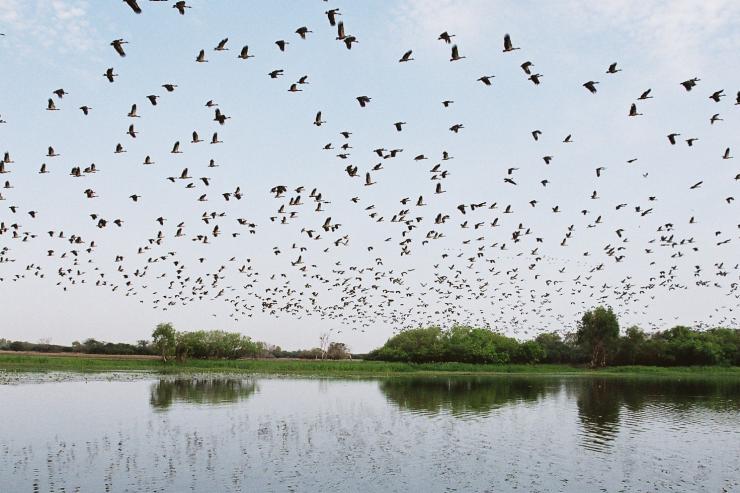
Hervey Bay, Queensland © Matthew Taylor, Tourism and Events Queensland
8 wildlife events to catch in winter
Where to experience the most extraordinary wildlife events during June, July and August.
By Amy Fraser
As the temperature drops during Australia’s winter, several wildlife species nestle in for months of hibernation, while others come out to play in full force. Lock eyes with supersized great white sharks, swim among hundreds of thousands of technicolour cuttlefish and tread through the snow with adorable wombats. If you’re looking for memorable experiences, you’ve hit the jackpot; here are eight uniquely Australian winter wildlife events.
Join dwarf minke whales in the water
When: Between June and July
Where: Ribbon Reef, Queensland
If you’re after a truly rare experience, dive into the waters at Ribbon Reef during Australia’s winter to discover phenomenal dwarf minke whales. These eight-metre-long whales may be small in size compared to their cousins, but they don’t half put on a show. You’ll most likely hear them first, as their galactical call (otherwise known as the ‘Star Wars sound’) vibrates through the ocean, sending a tingling sensation through your body. Before you know it, a majestic ghost-like creature will be playfully swirling around you. With the Great Barrier Reef being one of the only places in the world where you can swim with these wonderful creatures, it’s no surprise they revel at the chance to show-off their acrobatic skills and beautifully marked bodies.
How: Book a liveaboard experience to Ribbon Reef with Mike Ball Dive Expeditions during June and July.
See the world’s cutest love train
When: Mid to late winter
Where: In various locations across Australia
Toot toot! All-board the echidna love train. That’s right – while many animals take the winter as an opportunity to rest, Australia’s echidnas live up to their weird and wonderful name, forming the annual love train during the colder months of the year. The spectacle is both cute and uplifting, but the purpose of the train is far greater than amusing the likes of locals and travellers. Reaching up to ten animals long, the typically shy male echidnas unite nose to tail, ‘trailing’ a female echidna for days on end before one lucky male is chosen for breeding.
How: Join the two-day Kangaroo Island in Style tour with Exceptional Kangaroo Island.
Witness dancing birds
When: Visit during July and August for pleasant temperatures
Where: Outback Queensland
Australia’s largest flying bird, the brolga, just so happens to be quite the performer. Catch these graceful birds among Australia’s wetlands at the right time, and you’ll be dazzled by a spectacular dance. The ritual is typically performed by life-long partners, involving intricate head-bobbing, strutting and even trumpeting! According to Aboriginal legend, the dance comes from a young maiden who was transformed into a graceful bird after her dancing. Others believe the dance strengthens the bond between partners. If there’s one thing we know for sure, it’s a truly remarkable event to lay your eyes upon.
How: Take a road trip to Currawinya National Park where you’ll find swarms of brolgas around the park’s lakes.
Watch the ocean light up with technicolour cuttlefish
When: May to August
Where: Whyalla, South Australia
Between May and August each year, a swarm of technicolour creatures can be seen gliding through South Australia’s ocean as over 100,000 giant cuttlefish migrate to the shores near Whyalla to breed. These beautifully coloured cuttlefish, or ‘sepia apama’, are endemic to the Whyalla region, making the annual spawning all the more spectacular. Their glistening luminescent colours can be spotted easily in the shallow waters, but for the best view, you’ll want to pop a snorkel on to witness the full spectrum of these magnificent creatures.
How: Swim with giant cuttlefish on a two-day guided tour with PureSA.
Spot wombats on the snowy mountain tops
When: June to August
Where: Cradle Mountain, Tasmania
Visit Tasmania’s Cradle Mountain during the winter months and you’ll be in for a treat. The glistening white mountain tops create an enchanting landscape come day or night, but the real magic happens typically first thing in the morning when our furry friends come out to play. It’s not just us who enjoy frolicking in the snow; wombats are often seen – or heard – roaming around. Feel a rush of calm wash over you as you watch them tread over the mountain, their fur sprinkled with a dusting of snow.
How: Walk the Overland Track on a six-day walk with TAS Walking Co
Dive with supersized great white sharks

Rodney Fox Great White Shark Expeditions, Eyre Peninsula, South Australia © Tourism Australia
When: June and July
Where: Neptune Islands, South Australia
Fancy coming face-to-face with one of the world’s most talked-about predators? If you’re an adrenaline seeker, it’s time to step out of your comfort zone and into a cage, where you’ll meet the extraordinary great white shark in his own habitat. While they appear throughout the year in Australia, winter typically sees high numbers of great white sharks around South Australia’s Neptune Islands. And it’s not just the numbers that draw travellers to these waters during winter; the largest great whites are often seen at this time of year, measuring up to a whopping five metres (16.4-feet) long. Lock eyes with this spectacular giant and you’ll feel an adrenaline rush like no other.
How: Embark on the two-day Great White Shark Adventure tour with Rodney Fox Shark Expeditions.
Visit the whale watching capital of the world

Whale watching, Hervey Bay, Queensland © Tourism and Events Queensland
When: August
Where: Hervey Bay, Queensland
Queensland’s Hervey Bay, just 3.5 hours north of Brisbane, is a popular holiday spot – but not just for us. While locals and tourists enjoy the town’s laid-back atmosphere and beautiful beaches, between July and November, tens of thousands of migrating humpback whales also arrive for a well-deserved holiday from their 10,000-kilometre (6,000-mile) journey. The calm waters around Hervey Bay are perfect conditions for breeding, which makes for an extra special whale watching experience as you lay your eyes on families of whales with their calves. Whales are inquisitive animals, and more often than not they’ll want to see what you’re up to. In fact, whales in Hervey Bay are well-known for their playful antics, so whether you swim or sail next to these extraordinary animals, you’ll receive a warm welcome.
How: Hop aboard Blue Dolphins Tour’s vessel to meet and greet these marvellous marine animals.
Read next
8 wildlife events to catch in spring
Spot roos in the ranges

Yellow Footed Rock Wallaby, St Mary Peak, Flinders Ranges, South Australia © Andy Steven
When: Between June and August
Where: Flinders Ranges, South Australia
South Australia’s Flinders Ranges are vast and spectacular all year round, but winter’s cooler temperatures offer up extra special views. Visit these dramatic peaks between June and August and you’ll have a high chance of spotting a whole host of kangaroo and wallaby species as they soak up the pleasant temperatures in the wide-open landscape. Set your sights on western grey kangaroos, common wallaroos, red kangaroos and the rare yellow-footed rock wallaby. You’ll know if you’ve spotted one; these magnificent marsupials have a unique black, orange and yellow striped tail which often glows next to the sun-drenched red rock.
How: Head out on a 4WD Rawnsley Park Station Discovery Tour.



































































































































